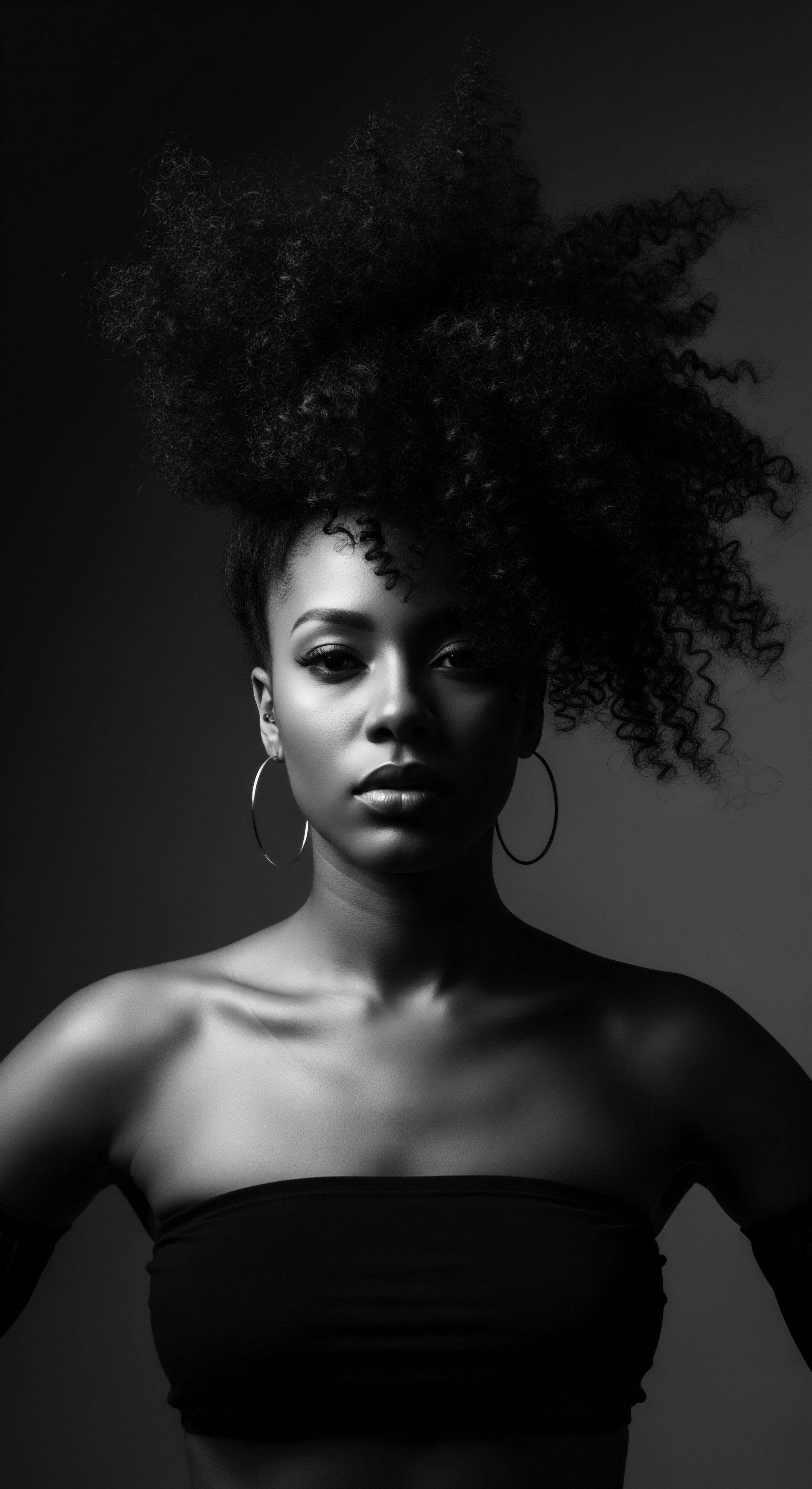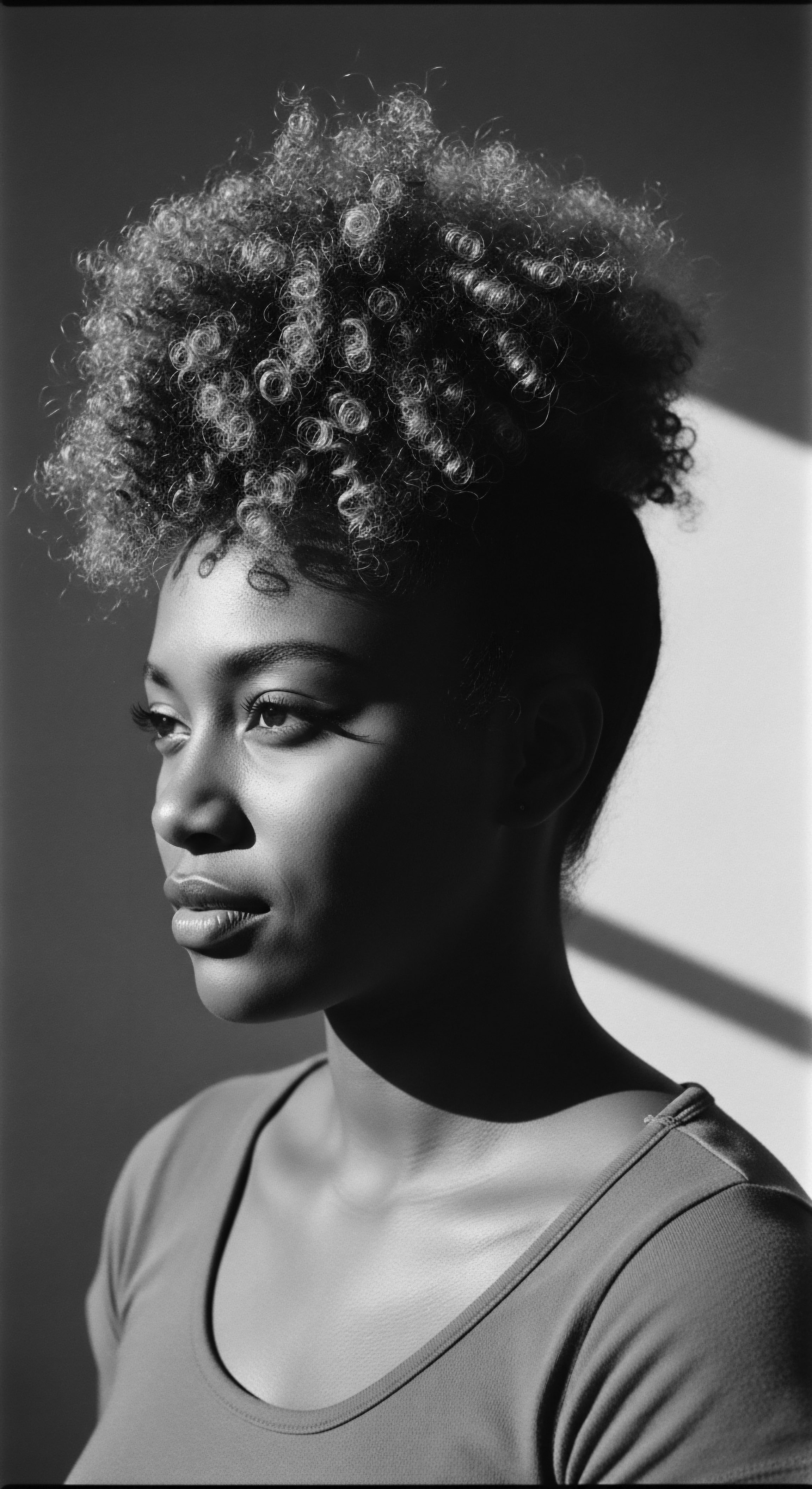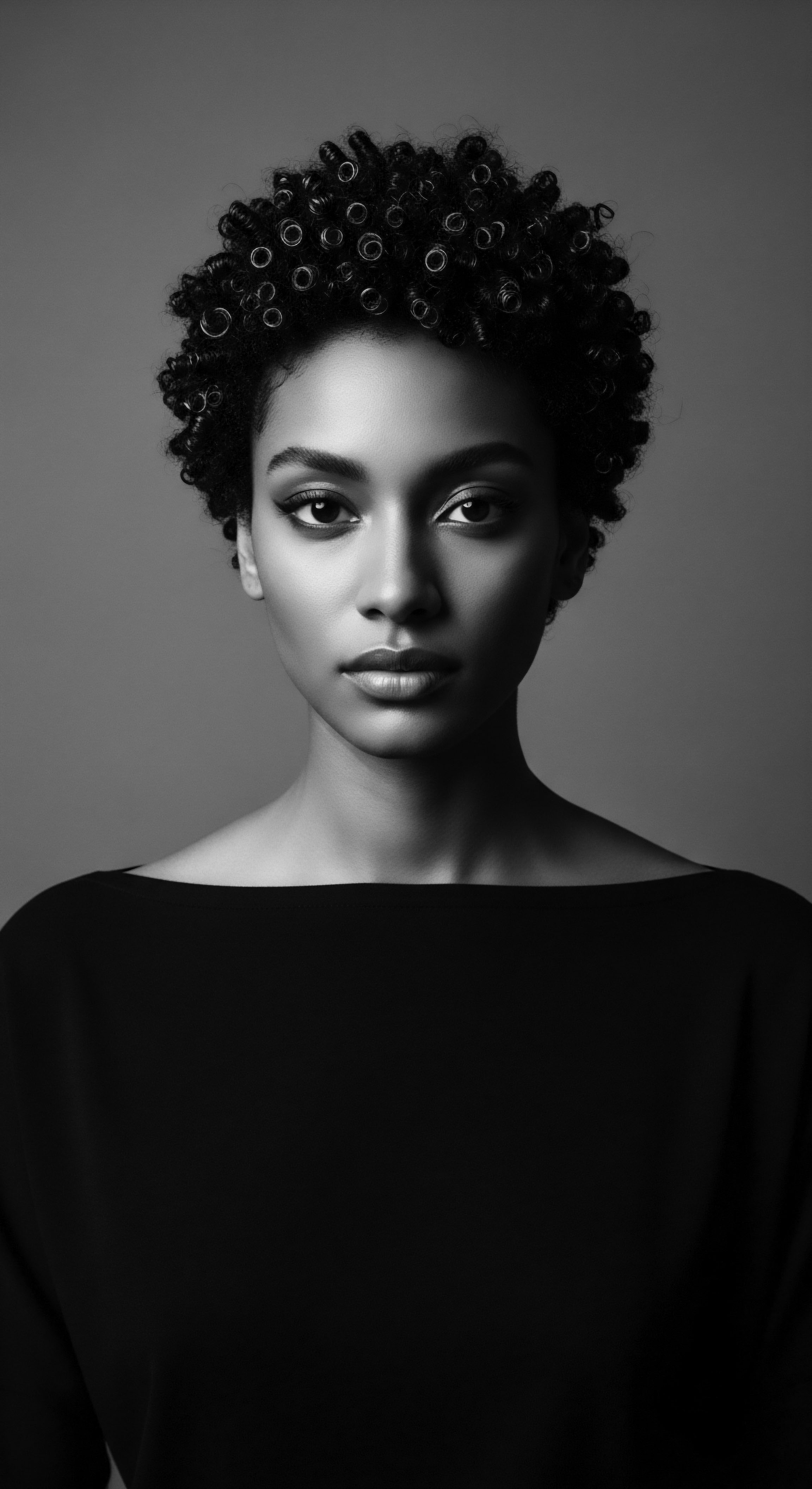
Roots
To journey into the heart of coiled hair care is to listen for the earth’s ancient whisper, a resonance that speaks of heritage, resilience, and elemental wisdom. For those whose strands coil and spring with a singular vitality, the connection to nature’s bounty, particularly the humble clay, holds a meaning beyond mere product. This is a story etched not only in the very structure of our hair but also in the long memory of ancestral hands that understood the profound gifts of the land. We approach this exploration with a sense of reverence, recognizing that every coil carries generations of narratives, each one a testament to identity and enduring strength.

What Gifts Does Earth Offer Our Coiled Strands?
The very ground beneath our feet holds secrets to hair wellness, secrets held within mineral-rich clays. These earthen wonders, born from volcanic ash or aged sediment, possess properties that speak directly to the needs of textured hair. Consider Bentonite Clay, often arising from ancient volcanic landscapes. Its molecular structure carries a negative electrical charge, allowing it to act like a magnet for positively charged impurities.
This includes environmental pollutants, excess sebum, and residual styling products that can accumulate on the scalp and hair fiber. The capacity of Bentonite clay to attract and bind to these elements means it can clarify and cleanse without harsh stripping, a gentle yet effective removal that respects the hair’s natural state.
Then there is Kaolin Clay, also known as white clay, a gentler earth material. It is composed primarily of kaolinite, a mineral found in abundance in the earth’s crust. Kaolin clay offers a more subtle absorbency, making it suitable for even sensitive scalps.
It helps to soak up surplus oils and impurities while maintaining a healthy moisture balance for the scalp and hair. This lighter touch is especially relevant for coiled hair, which often seeks cleansing without the sacrifice of precious moisture.
Another significant earth offering is Rhassoul Clay, also known as Ghassoul clay, sourced from the Atlas Mountains of Morocco. This particular clay is distinguished by its unique mineral composition, boasting high levels of silica, magnesium, potassium, and calcium. The name ‘Rhassoul’ itself comes from the Arabic word ‘rhassala’, meaning ‘to wash’, a testament to its long historical use as a cleansing agent. Rhassoul clay’s properties extend to softening and hydrating the hair, providing a smoother appearance and lessening frizz.
The earth’s clays provide a direct link to ancestral practices, offering mineral-rich cleansing and care for coiled strands.
These clays, while distinct in their specific properties, share a common thread of beneficial mineral content. They are not merely cleansing agents; they are mineral repositories.
- Silica ❉ A building block for collagen production, supporting hair strength and reducing breakage.
- Magnesium ❉ Helps counteract calcium buildup on the scalp, which can obstruct hair follicles.
- Calcium ❉ Crucial for regulating sebum production and supporting cellular regeneration.
- Potassium ❉ Contributes to balanced effects throughout the body, including factors impacting hair growth.
- Iron ❉ Especially in Rhassoul clay, it can revitalize dormant follicles by stimulating blood circulation.
Understanding these mineral properties helps us appreciate the wisdom embedded in ancestral practices. The effectiveness observed by those who came before us, using the earth’s gifts for hair care, finds a grounding in contemporary scientific understanding.

Ritual
The application of clays to coiled hair is more than a routine; it is a ritual, a continuation of practices passed down through generations. These acts of care hold echoes of communal gatherings, moments of tender touch, and a deep respect for the body and spirit. The historical use of clays in African communities for hair and body beautification dates back millennia.
For example, in the Igbo community of Nigeria, women utilized clays like Edo to color their hair, a practice deeply entwined with aesthetic expression. Similarly, the Himba women of Namibia traditionally cover their entire bodies and hair in a mixture of animal fat and red ochre, a type of clay rich in iron oxide, a practice that offers protection against UV rays.

How Do Ancient Customs Inform Modern Applications of Clay?
The wisdom of these ancient customs, though perhaps not articulated in scientific terms then, recognized the palpable benefits of clays. The adsorptive qualities of clays like Bentonite, for instance, are not new discoveries. Ancient practitioners likely observed how these earth materials cleansed the hair, removed impurities, and left it feeling fresh. This ‘magnet-like’ action, where negatively charged clay attracts positively charged debris, was understood through observed results, not chemical equations.
When moistened, Bentonite clay creates a smooth paste, which when applied to hair, binds to dirt, oil, and product buildup. Upon rinsing, these attached impurities are carried away, leaving the hair feeling lighter and revitalized. This is particularly useful for coiled hair, which often requires significant product for styling, leading to accumulation over time.
Rhassoul clay, with its gentle detangling properties, offers another window into ancestral practice. The very act of working the clay through coiled strands could have served not only as a cleansing step but also as a way to soften and separate curls, minimizing breakage. The fine, silky texture of Rhassoul clay helps smooth the hair fiber, reducing tangles that can cause damage during grooming. This would have been particularly valuable in communities where extensive styling, like intricate braiding, was common.
The historical application of clays in coiled hair care transcends mere aesthetics, encompassing cleansing, protection, and communal connection.
Beyond cleansing, clays play a role in maintaining scalp health. A healthy scalp serves as the foundation for healthy hair. Clays assist in balancing sebum production, a common concern for many with coiled hair, and can help alleviate irritation or flaking. This holistic view of care, where scalp and hair health are intertwined, is deeply rooted in ancestral wellness philosophies that recognized the interconnectedness of all bodily systems.
Consider the Sanburu and Rendille Cultures, where warriors practice a ritualistic hair-dyeing process using red ochre clay and animal fat. This is not solely for aesthetic purposes; it signifies status and identity. The application of such mixtures, traditionally, also protected the hair from environmental elements and contributed to its overall health. The inherent minerals within the red ochre (iron oxide) could have provided nourishing qualities, while the animal fat offered conditioning, demonstrating an intuitive understanding of protective and beautifying properties.
| Clay Type Bentonite |
| Historical/Traditional Use Cleansing without stripping, removal of accumulated residue in various African and Indigenous beauty practices. |
| Contemporary Scientific Link High adsorption capacity due to negative charge, binding to positively charged impurities (toxins, heavy metals, product buildup). |
| Clay Type Kaolin |
| Historical/Traditional Use Gentle purification, oil absorption for scalp balance, seen in East Asian and African cosmetic customs. |
| Contemporary Scientific Link Mild absorbency, beneficial for sensitive scalps, helps regulate sebum production while preserving moisture. |
| Clay Type Rhassoul |
| Historical/Traditional Use Washing, softening, detangling hair in North African Hammam rituals. |
| Contemporary Scientific Link Rich in silica, magnesium, potassium, calcium; softens hair, improves manageability, and reduces frizz. |
| Clay Type These clays, utilized across generations, bridge ancient wisdom with current scientific understanding of hair care. |

Relay
The story of coiled hair care is one of continuous transmission, a relay race where ancestral wisdom, often expressed through the application of clays, is passed from one generation to the next. This unbroken chain of knowledge links past ingenuity to present-day understanding, demonstrating how the properties of these earth minerals continue to shape hair health and cultural expression.

What Historical Data Supports Clay’s Benefit to Coiled Hair?
While formal scientific studies on ancient practices can be rare, ethnobotanical accounts and historical records provide strong evidence of clay use for hair health across African communities. For instance, in the Igbo Community of Nigeria, historical accounts describe women using ‘edo’ (a type of clay) to color their hair. While primarily for aesthetics, the application of such natural earth materials would have concurrently offered cleansing and conditioning benefits, given the inherent properties of clays to absorb oils and provide minerals. Another compelling example comes from the Himba People of Namibia.
Himba women apply a mixture of red ochre clay and butter fat to their hair, forming thick braids. This practice is not solely decorative; anthropological research indicates that this mixture provides protection against the harsh sun and repels insects. (Rifkin, 2012) The presence of iron oxide in red ochre clay and the moisturizing properties of butter fat work in concert to shield the hair and scalp, showcasing a sophisticated, time-tested approach to hair care rooted in the natural environment. This particular case study provides insight into the intuitive use of earth elements for multifaceted hair and scalp wellness within a specific cultural context.
This traditional knowledge, sometimes seen as anecdotal, finds validation in modern scientific investigation. Studies have shown Bentonite clay’s impressive adsorption properties that help in detoxifying and purifying the scalp, along with providing essential minerals for hair health. Its negative charge attracts positively charged product buildup and heavy metal toxins, leading to thoroughly cleansed hair. Similarly, Rhassoul clay’s high content of magnesium and silica contributes to its ability to remineralize and condition hair, cleansing without stripping natural oils, and enhancing curl definition.
The persistence of these clay practices speaks to their efficacy and cultural significance. The ritualistic application, often a communal activity, reinforces bonds and transmits knowledge across age groups. In many African cultures, hair care practices were, and remain, deeply social, a time for sharing wisdom and strengthening community ties.

How Does Clay Contribute to Hair’s Lasting Strength?
The mineral properties of clays contribute to hair’s resilience by addressing several common challenges faced by coiled hair:
- Cleansing without Stripping ❉ Coiled hair can be prone to dryness. Traditional shampoos often contain sulfates that can strip the hair of its natural oils. Clays offer a gentle alternative, absorbing excess oils and impurities while preserving the hair’s hydrolipidic film. This helps maintain moisture balance, which is essential for preventing breakage and maintaining elasticity.
- Scalp Environment Balance ❉ A healthy scalp is the ground from which hair grows. Clays help regulate sebum production, soothe irritation, and combat issues like flaking or dandruff. By promoting a balanced scalp pH, clays create an optimal environment for hair follicles, supporting overall hair health.
- Mineral Replenishment ❉ Hair can benefit from direct mineral application. Clays offer a spectrum of elements like silica, magnesium, calcium, and potassium, which contribute to strengthening the hair shaft. This replenishment aids in making strands more resilient to physical manipulation and environmental stressors.
The knowledge of clays and their specific mineral compositions allows for a more informed approach to modern hair care, one that respects the lineage of practices that have sustained coiled hair through time.
The modern natural hair movement, while embracing innovation, often circles back to these time-honored ingredients. The understanding that truly vibrant hair comes from a harmonious relationship with nature, a principle long held by ancestral communities, continues to guide product development. This deep respect for indigenous knowledge systems, which long ago recognized the value of earth’s gifts for beauty and well-being, is a testament to their enduring relevance.

Reflection
As we consider the elemental bond between clays and coiled hair, a profound truth emerges ❉ our hair is a living archive, holding the echoes of generations. The very texture of a coil whispers stories of survival, artistry, and an unbreakable connection to the land from which our ancestors drew sustenance. The mineral properties of clays are not just chemical compositions; they are gifts from the earth, understood and utilized by those who walked before us, becoming an integral part of a textured hair heritage that continues to shape identity and cultural pride.
Each wash with a mineral clay, each moment of care, becomes a conscious act of engaging with this deep history. It is a recognition of the ingenious methods developed in challenging circumstances, where access to manufactured products was nonexistent, yet ingenuity and observation of the natural world provided solutions. The simple act of mixing earth with water to cleanse and nourish connects us to a lineage of resilience, a continuum of care that spans continents and centuries. This understanding elevates the common clay from a mere ingredient to a symbol of sustained cultural legacy, a silent guardian of our hair’s living memory.

References
- Rifkin, R.F. (2012). Preliminary results indicate that the red ochre applied by women confers a significant degree of protection against UV rays. University of Witwatersrand.
- Clinikally. (2025, February 20). Bentonite Clay Hair Mask ❉ The Natural Way to Detox and Revive Your Hair. Retrieved from Clinikally.
- Cambridge University Press. (2024, January 1). Clays in Cosmetics and Personal-Care Products. Retrieved from Cambridge University Press.
- Argiletz. Ghassoul clay ❉ benefits and uses in beauty care. Retrieved from Argiletz.
- NaturAll Club. (2021, March 22). How to Revive Natural Hair with Bentonite Clay. Retrieved from NaturAll Club.
- Healthline. (2018, March 29). Bentonite Clay for Hair ❉ Benefits, How to Use, Mask Recipe. Retrieved from Healthline.
- Safo Hair. (2024, February 15). The Evolution of Black Hair Products ❉ A Journey from Homemade Remedies. Retrieved from Safo Hair.
- HK Vitals. (2023, September 21). Kaolin Clay ❉ Know Its Benefits for Your Hair. Retrieved from HK Vitals.
- CMS Industries. (2025, February 5). Amazing Benefits of Bentonite Clay on 4C Hair. Retrieved from CMS Industries.
- Root and Muddle. (2022, March 20). Ingredient Highlight ❉ Kaolin Clay. Retrieved from Root and Muddle.
- KaolinClay.ca. Kaolin Clay Benefits. Retrieved from KaolinClay.ca.
- My Chic Curls. Detox for Healthy Hair ❉ Unlock the Power of Rhassoul and Bentonite Clay. Retrieved from My Chic Curls.
- Vinci Hair Clinic. (2022, February 16). Why Kaolin Clay Is A Powerhouse Ingredient For Oily Hair. Retrieved from Vinci Hair Clinic.
- Igbocurls. DIY Bentonite Clay Hair Mask for Hair Growth on 4c Hair. Retrieved from Igbocurls.
- Goldie Locks. Bentonite Clay For Hair & Its Benefits. Retrieved from Goldie Locks.
- Bingo Cosmetic Manufacture Ltd. (2024, July 24). The Benefits of Kaolin Clay in Matte Styling Products. Retrieved from Bingo Cosmetic Manufacture Ltd.
- Kenra Professional. From Ancient Rituals to Modern Results ❉ Global Haircare Traditions Inspiring Kenra Professional. Retrieved from Kenra Professional.
- YouTube. (2017, December 7). How CLAY DETOXIFIES Your Hair – Science Explained. Retrieved from YouTube.
- Lagzira London. 10 Benefits of Moroccan Clay Powder Ghassoul for Skin and Hair. Retrieved from Lagzira London.
- Daily Maverick. (2021, January 15). On the therapeutic use of clay. Retrieved from Daily Maverick.
- MDPI. The Scenario of Clays and Clay Minerals Use in Cosmetics/Dermocosmetics. Retrieved from MDPI.
- Nowiamnappy’s. (2019, August 27). Rhassoul Clay Benefits and Uses for Hair and Skin, and Precautions. Retrieved from Nowiamnappy’s.
- Sellox Blog. (2021, June 4). Ancient African Hair Growth Secrets For Healthy Hair. Retrieved from Sellox Blog.
- Curl Fans. (2022, February 6). Clay Wash – Every Thing About it – A center for curly hair. Retrieved from Curl Fans.
- Delek Tulum. The Healing Power of the Mayan Clay Ritual. Retrieved from Delek Tulum.
- Roots to Curls. Benefits of Rhassoul Clay for Hair. Retrieved from Roots to Curls.
- Refinery29. (2021, February 23). The Evolution Of The Natural Hair Movement. Retrieved from Refinery29.
- Argiletz. (2024, January 22). Rhassoul ❉ a ritual for hair and skin care to purify and relax body and soul. Retrieved from Argiletz.
- BIOVIE. What are the benefits of rhassoul clay? Retrieved from BIOVIE.
- TikTok. (2025, February 13). Hair Dyeing Rituals in Samburu and Rendille Culture. Retrieved from TikTok.
- Beautycon.com. (2018, November 21). Top 10 Clay Masks for Curly Hair. Retrieved from Beautycon.com.
- ResearchGate. (2018, January). Data from studies on adsorption capacity of GHA for various organic. Retrieved from ResearchGate.
- Bingo. (2024, May 31). Curly Hair Care- The Benefits of Organic Hair Clay for Defined Curls. Retrieved from Bingo.
- Regirl. (2021, October 10). Bentonite Clay For Natural Hair ❉ Benefits, How to Use, and DIY Mask Recipe. Retrieved from Regirl.
- Neelkanth Finechem LLP. Rhassoul Clay. Retrieved from Neelkanth Finechem LLP.
- MINATURE. (2024, November 25). Benefits and Uses Of Moroccan Rhassoul Clay for Hair & Skin. Retrieved from MINATURE.
- Library of Congress. Heavy is the Head ❉ Evolution of African Hair in America from the 17th c. to the 20th c. Retrieved from Library of Congress.
- Indara Naturals. Ayurvedic Clay Wash | Rhassoul Clay Hair & Scalp Cleanser. Retrieved from Indara Naturals.
- Minimalist Beauty. Rhassoul Clay Versus Bentonite Clay. Retrieved from Minimalist Beauty.
- Sabinet African Journals. Indigenous knowledge applied to the use of clays for cosmetic purposes in Africa ❉ an overview. Retrieved from Sabinet African Journals.
- YouTube. (2022, June 20). Is this the Original Clay Hair Mask?| Hair History in Africa. Retrieved from YouTube.
- ResearchGate. (2023, August 16). (PDF) Characterization of South African Bentonite and Kaolin Clays. Retrieved from ResearchGate.
- Khumbula. (2024, April 16). A Crowning Glory ❉ Hair as History, Identity, and Ritual. Retrieved from Khumbula.
